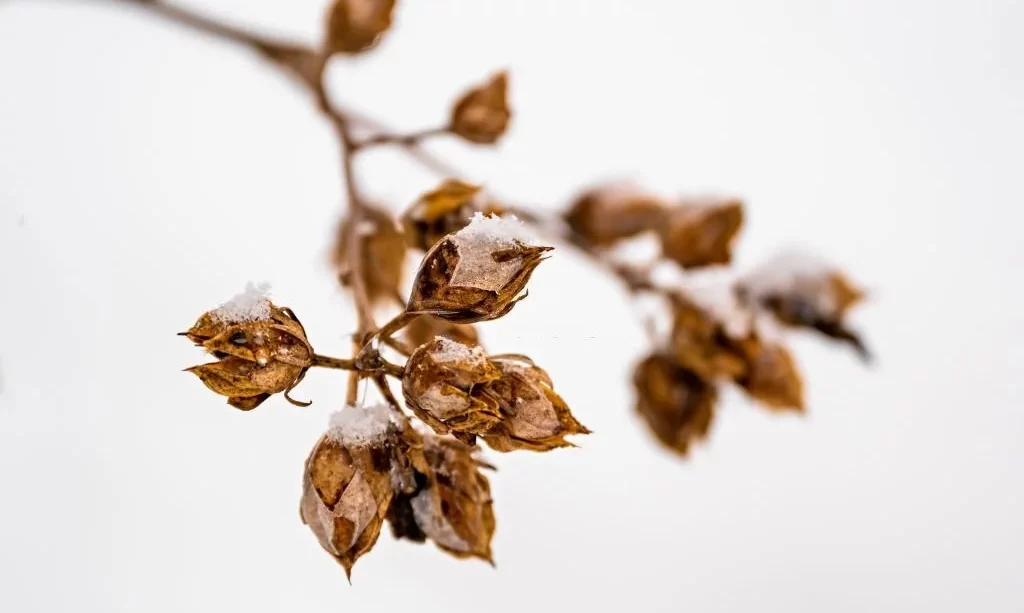Hibiscus plants, with their vibrant, exuberant blossoms, are a garden favorite, adding a touch of tropical elegance to landscapes. Yet, as the seasons change and winter’s chill approaches, a question often arises: Can hibiscus survive the cold? The answer to this inquiry hinges on the specific type of hibiscus you cultivate. In this guide, we will explore the world of hibiscus plants, distinguish between hardy and tropical varieties, and delve into the crucial factors that determine whether these stunning blooms can brave the challenges of winter.
- Tender annual. In frost-free zones, Hibiscus can survive as a perennial. In all other areas, treat it as an annual
- Plant arrives approximately 36-inches tall, measured from the bottom of the pot to the top of the plant. Potted in a 10-inch diameter grower pot
- Grow Hibiscus in full sun outdoors for the best growth and enjoy
- Water Hibiscus with approximately 2-3 cups of water about twice a week. Adjust as needed for your environment
Types of Hibiscus Plants
Before we embark on the quest to understand hibiscus survival in winter, let’s acquaint ourselves with the diverse world of hibiscus plants:
- Hardy Hibiscus: These hibiscus varieties, also known as perennial or garden hibiscus, belong to the Hibiscus moscheutos family. They are native to North America and are adapted to withstand colder temperatures. Hardy hibiscus varieties are well-suited for gardens in temperate regions.
- Tropical Hibiscus: Tropical hibiscus, scientifically categorized as Hibiscus rosa-sinensis, originate from warm, tropical and subtropical regions. These hibiscus plants are not cold-tolerant and thrive in warm climates.
Hardy Hibiscus vs. Tropical Hibiscus
The distinction between hardy and tropical hibiscus is pivotal in understanding their winter survival capabilities:
- Hardy Hibiscus: These hibiscus plants are remarkably resilient in colder climates. They can withstand frost and even snow, provided they receive proper winter care. Hardy hibiscus varieties typically die back to the ground in winter but resprout in the spring from their root systems. With the right care, they can thrive in zones with cold winters.
- Tropical Hibiscus: Tropical hibiscus, in contrast, are not equipped to handle cold temperatures. They are sensitive to frost and should be protected from any temperatures below 50°F (10°C). In regions where winters are cold, potted tropical hibiscus should be brought indoors or placed in a sheltered, heated area to survive the winter.
Understanding the type of hibiscus you have is the first step in determining how to care for them as winter approaches. In the sections ahead, we will explore the specific winter care needs of hardy and tropical hibiscus, ensuring that these stunning blooms continue to grace your garden year after year.
Preparing Hardy Hibiscus for Winter
Hardy hibiscus varieties are naturally more equipped to brave winter’s cold, but they still benefit from thoughtful preparation:
- Timing is Key: As the growing season nears its end, gradually reduce fertilization and cease pruning. This encourages the plant to focus energy on root growth and hardening off for winter.
- Mulching Matters: Apply a layer of mulch around the base of the hibiscus to insulate the roots. This layer should be approximately 3-4 inches (7-10 cm) thick. Mulch acts as a protective blanket, helping the roots withstand freezing temperatures.
- Watering Adjustments: As winter approaches, reduce watering but ensure the plant receives adequate moisture. Water deeply before the first freeze to hydrate the roots and help them endure winter’s dry spells.
- Insulation for Stems: For added protection, you can wrap the stems of hardy hibiscus with burlap or frost cloth. This safeguards the upper parts of the plant from harsh winter winds and cold snaps.
- Formulated for the unique growing habits of Hibiscus
- Developed and used by commercial hibiscus growers in Homestead, FL
- Applied directly on top of soil & mulch, no mixing required
- 2lb bag is equipped with a resealable top for easy storage
Winter Care for Tropical Hibiscus
Tropical hibiscus, being less cold-tolerant, require special attention during the winter:
- Bring Indoors: Before the first frost arrives, potted tropical hibiscus should be moved indoors. Find a bright, sunny spot for them near a window to ensure they receive adequate light. Keep the indoor temperature above 50°F (10°C).
- Humidity and Moisture: Tropical hibiscus thrive in humid conditions. To mimic their native habitat, consider using a humidity tray or a humidifier to maintain moisture levels around the plant. Keep the soil consistently moist but not waterlogged.
- Light Exposure: Tropical hibiscus still require ample light during the winter. If natural light is insufficient, supplement with fluorescent or grow lights to provide the necessary light for healthy growth.
- Pruning and Repotting: You can prune your tropical hibiscus lightly in the early spring to encourage new growth. Repotting may also be necessary if the plant has outgrown its container.
Protecting Hibiscus in Marginal Climates
Gardeners in regions with borderline winter temperatures face a unique set of challenges:
- Covering Strategies: Consider using frost cloth or blankets to cover both hardy and tropical hibiscus during freezing nights. Ensure that the coverings do not touch the plant directly and are anchored securely.
- Temporary Shelter: If your garden is susceptible to unexpected frosts, consider placing hibiscus pots in a temporary shelter, like a greenhouse or a well-ventilated garage, during extreme cold spells.
- Microclimate Creation: Experiment with microclimate creation by placing hibiscus containers near heat-absorbing surfaces, like brick walls, during the day. These surfaces radiate warmth at night, providing some protection.
By tailoring your winter care to the specific type of hibiscus you have and considering the climate in your region, you can ensure the survival and health of these stunning blooms through the winter months. With thoughtful preparation and attention, your hibiscus plants will emerge from their winter slumber ready to dazzle your garden once again come spring.
Winter Troubleshooting and Recovery
Sometimes, despite your best efforts, hibiscus plants may encounter issues during the winter. Here’s how to troubleshoot and aid their recovery:
- Frost Damage: If frost damage occurs on hardy hibiscus, don’t be discouraged. Wait until the danger of frost has passed in spring, and then prune away the damaged portions. The plant often regenerates from its roots.
- Insect Infestations: Inspect your hibiscus for overwintering pests that may have taken shelter on the plant. Treat any infestations promptly using safe insecticides, following the manufacturer’s instructions.
- Potted Hibiscus: Check potted hibiscus plants indoors regularly for signs of stress, such as yellowing leaves or drooping. Adjust humidity, light exposure, and watering as needed to support their well-being.
- PLEASE CHOOSE HEAT PACK OPTION IF NIGHT TEMPERATURES ARE BELOW 38F
- Environment: The tropical Hibiscus plant loves sun.
- Bloom Time: Year Round; Hibiscus plants produce beautiful flowers!
- Overall Size: 34″ to 38″ tall including the 10″ planter.
- USDA Plant Hardiness Zone: 9 to 11; Watering: High; Hibiscus plants love water!
Spring Care and Pruning
As winter retreats and the promise of spring beckons, it’s time to prepare your hibiscus plants for a new season of growth:
- Pruning in Spring: In early spring, before new growth begins, prune both hardy and tropical hibiscus. Remove dead or damaged branches and shape the plant as desired. Pruning encourages new growth and fuller, bushier plants.
- Gradual Resumption of Care: Gradually reintroduce your hibiscus to its normal care routine. Begin regular watering and fertilization as the weather warms up and growth resumes. Adjust to your region’s climate conditions.
- Repotting: If your potted hibiscus has outgrown its container, consider repotting it in early spring. Choose a slightly larger pot with well-draining soil to accommodate its growth.
Conclusion
The ability of hibiscus to survive the winter largely depends on their type and the care they receive during the colder months. Hardy hibiscus, with proper preparation and protection, can withstand cold temperatures and come back to life in spring. In contrast, tropical hibiscus require indoor shelter from frost and tailored care to thrive.
By following the appropriate winter care guidelines for your hibiscus variety and addressing any winter-related issues promptly, you can ensure the resilience and vitality of these striking plants. As spring unfolds, your hibiscus will reward your efforts with vibrant blooms and lush foliage, brightening your garden and ushering in a new season of beauty. Remember that the key to successful hibiscus care is understanding their unique needs and adapting your gardening practices accordingly.






